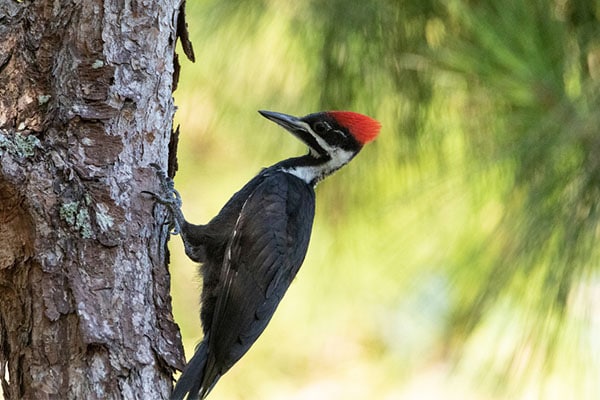Contents
- Pileated woodpecker facts
- Pileated woodpecker: how-to identify
- Pileated woodpecker bird vocalization
- Where You’ll See Pileated Woodpeckers
- Pileated woodpecker diet
- Pileated woodpecker nesting
- Pileated woodpecker behavior
- How-to attract pileated woodpeckers
- Pileated woodpecker threats
- Pileated woodpecker fun & interesting facts
- Pileated woodpecker related species in this family
The Pileated Woodpecker is one of the largest and most striking forest birds found in North America. They are almost the size of crows and are known as the largest woodpeckers in North America. They are found in many habitats, including areas near human settlements like parks or even edges of large cities.
In this article, we will learn more about Pileated Woodpecker. We’ll discuss:
- How to identify them
- Where you’ll find them
- What they eat
- How they nest
- Their behaviors
- How to attract them
- Their conservation status
- Interesting facts
So if you want to learn more about these birds, read on as we go through all the bird facts…
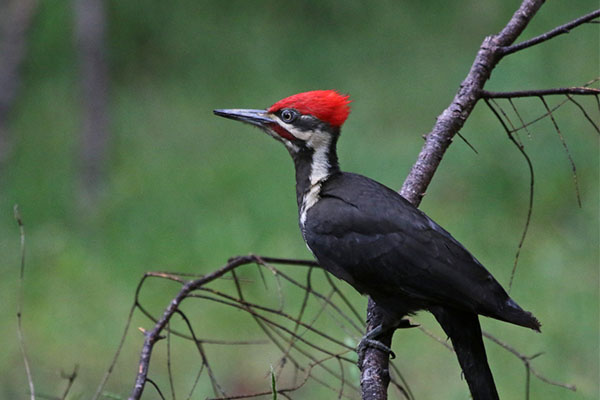
Pileated woodpecker facts
- Common Name: Pileated Woodpecker
- Scientific Name: Dryocopus pileatus
- Scientific Family: Picidae
- Life Span: 13 years
- Size: 15.8 to 19.3 inches
- Wingspan: 26.9 to 29.5 inches
- Weight: 8.8 to 12.3 oz
- Conservation status: Low Concern
Pileated woodpecker: how-to identify
Pileated Woodpeckers are very large woodpeckers with long necks and triangular crests. They grow at approximately 15.8 to 19.3 inches in length, 8.8 to 12.3 ounces in weight, and around 26.0 to 29.5 inches wingspan.
The birds feature an overall black plumage, with a white stripe on their swings and faces. When they open their wings wide, you’ll notice that the upper part is colored white. Another identification you’ll notice is that they have a large red crest on their heads.
Differences Between Male & Female
Male and female Pileated Woodpeckers look pretty similar, except for a red patch found on the cheeks of male Pileated Woodpeckers.
Differences In Summer Plumage vs Winter Plumage
Pileated Woodpeckers look the same all year round, regardless of the season.
Pileated woodpecker bird vocalization
Where You’ll See Pileated Woodpeckers
Pileated Woodpeckers are found in lower Canada, parts of Washington, Oregon, California, and eastern parts of the US from Minnesota down to Florida.
These birds prefer to live in mature deciduous or mixed forests, but they can also be found in other habitats, including young forests, suburban areas with large trees, and patches of woodlands.
Pileated woodpecker diet
Pileated Woodpeckers eat lots of insects, but their favorite is carpenter ants. These are then supplemented by other insects like woodboring beetle larvae, termites, flies, caterpillars, cockroaches, grasshoppers, and other types of ants.
Apart from insects, they also eat fruits and nuts, including hackberry, blackberries, sumac berries, elderberries, poison ivy, dogwood, and dogwood. They also visit bird feeders for seeds and suet, especially when the winter season comes.
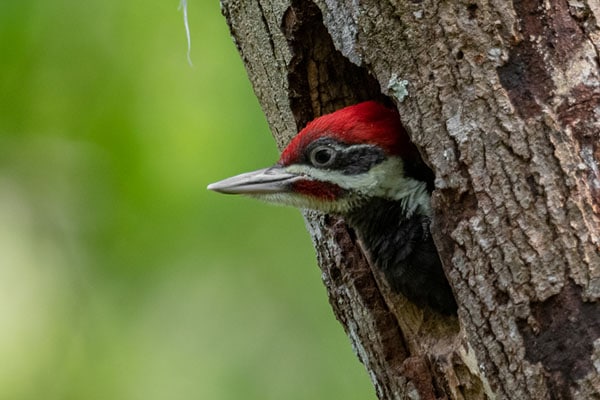
Pileated woodpecker nesting
- Clutch Size: 5-8 eggs
- # of Broods: 1 brood
- Incubation Period: 11-13 days
- Nestling period: 24-27 days
- Egg Description: All White
Pileated Woodpeckers nest in trees that are typically dead and are found in mature or younger forests. They excavate cavities around 15-80 feet aboveground and generally make new cavities every year.
The male birds are the ones that do most of the excavation. They start the nest excavation, and then the female helps with the finishing touches. And while most woodpeckers make a circular opening, Pileated Woodpeckers make their entrance oblong-shaped instead.
Nest cavities are not lined with any nesting material. Instead, the birds often pick several wood chips and throw them inside.
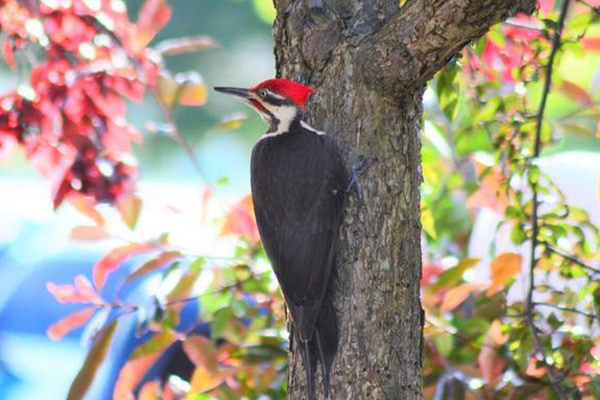
Pileated woodpecker behavior
Pileated Woodpeckers forage mainly by probing, prying, and excavating in deadwood in search of insects, especially their favorite carpenter ants. They make impressive excavations that can be a foot long or longer than that, sometimes even going deep inside the wood.
These birds are monogamous and hold large territories. They defend their territory by creating loud drumming sounds and ringing.
Courtship displays often include spreading their wings, raising their crests, swinging their heads, and gliding while in flight. Their flying is described as strong and undulating, and their wingbeats are quick but not at the same speed all the time.
How-to attract pileated woodpeckers
Attracting Pileated Woodpeckers is generally the same as attracting other woodpeckers. Provide them with the food they need, nesting sites, and water.
As these are resident birds, there’s a good chance that they’ll pass by your backyard to feed, especially in winter. Some of the food you can offer them are suet, bark butter, shelled peanuts, safflower seeds, sunflower seeds, and birdseed mixes.
You can make your yard more insect-friendly and if there are dead or dying trees around you, avoid clearing them. These trees would help provide food resources for these birds and even nesting sites.
The next thing you can do is plant some fruit-bearing trees and shrubs to provide fruits and berries for these birds. And most of all, don’t forget to serve them water by providing a birdbath. If possible, choose a heated birdbath so the water wouldn’t freeze when the winter season comes.
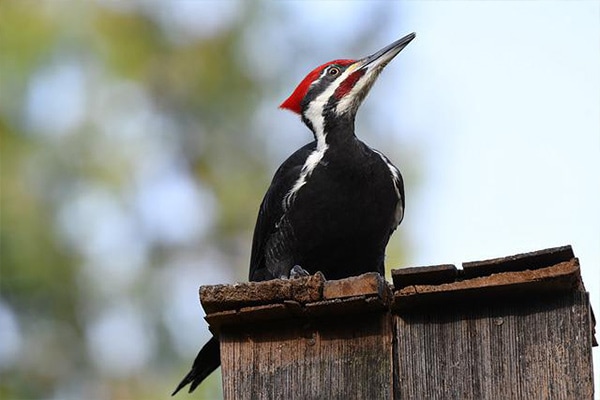
Pileated woodpecker threats
Pileated Woodpeckers may not be seen in many parts of North America, but they are pretty common birds. Their population has been steadily increasing, putting them on the list of species of low concern.
Pileated woodpecker fun & interesting facts
- Pileated Woodpeckers are known for the rectangular holes they dig on trees to find ants.
- Their feeding excavations are wide that they easily attract other birds.
- These birds sometimes use telephone or power line poles for nesting.
- Their pecking activity can often cause severe damage to trees.
- Their populations once declined in the 19th and 20th centuries because of logging activity.
- The oldest recorded Pileated Woodpeck is at least 12 years and 11 months old.
- Williamson’s Sapsucker
- Yellow-bellied Sapsucker
- Red-naped Sapsucker
- Red-breasted Sapsucker
- Lewis’s Woodpecker
- Acron Woodpecker
- Gila Woodpecker
- Golden-fronted Woodpecker
- Red-bellied Woodpecker
- American Three-toed Woodpecker
- Black-beaded Woodpecker
- Downy Woodpecker
- Nuttall’s Woodpecker
- Red-headed Woodpecker
- Ladder-backed Woodpecker
- Hairy Woodpecker
- White-headed Woodpecker
- Arizona Woodpecker
- Ivory-billed Woodpecker
- Northern Flicker
- Red-cockaded Woodpecker
- Gilded Flicker

